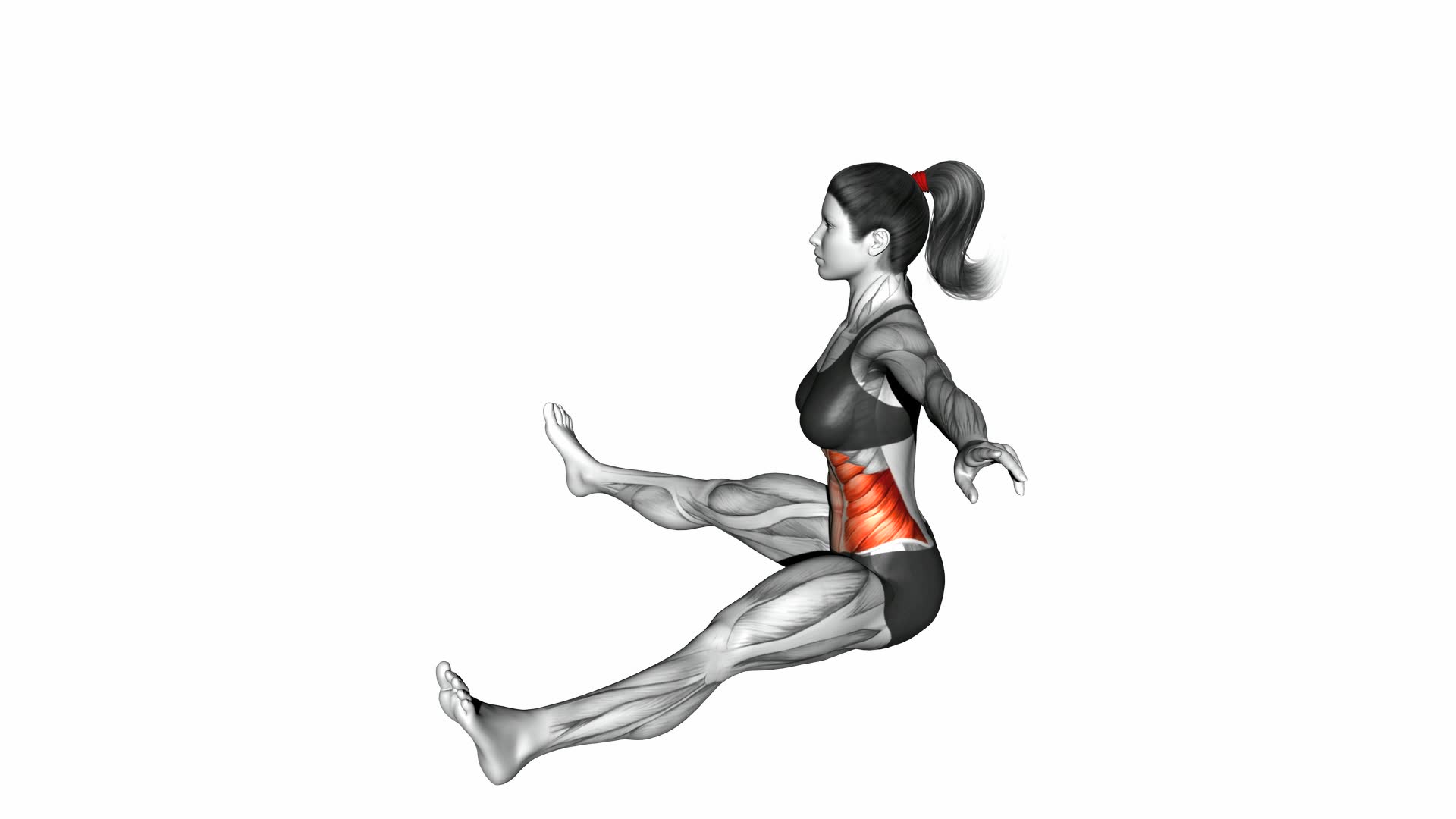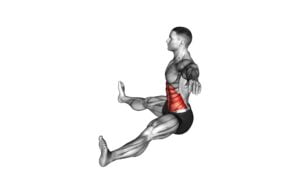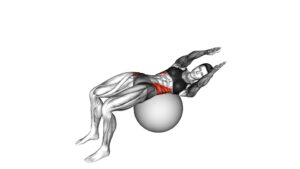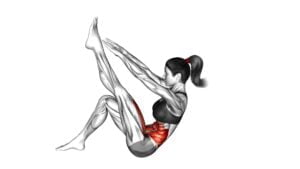Seated Twist (Straight Arm) – Video Exercise Guide & Tips

Are you looking for a quick and effective way to stretch your muscles? Look no further than the seated twist (straight arm) exercise!
Watch This Exercise Video
This video exercise guide and tips will show you how to properly perform this exercise, with modifications for beginners and advanced variations for those looking to challenge themselves.
Get ready to maximize your results and improve your flexibility with this simple yet effective exercise. Let's get twisting!
Key Takeaways
- Seated twist improves flexibility in the spine, hips, and shoulders.
- Engaging the core and maintaining proper form is crucial for an effective seated twist.
- Modifications are available for beginners and individuals with limited flexibility.
- Advanced variations and progressions can be incorporated to further strengthen and tone the core.
Benefits of Seated Twist
The seated twist exercise provides numerous benefits for your overall flexibility and core strength. There are several variations of the seated twist that you can incorporate into your workout routine to target different muscle groups and increase your flexibility.
One variation is the seated twist with straight arms. To perform this exercise, sit on the floor with your legs extended in front of you. Place your hands on the floor behind you, fingers pointing towards your back. Engage your core and twist your torso to the right, keeping your back straight. Hold the stretch for a few seconds, then return to the starting position. Repeat on the left side.
This seated twist variation helps to improve flexibility in your spine, hips, and shoulders. It also strengthens your core muscles, including your obliques and lower back.
Proper Form and Technique
To perform the seated twist exercise with straight arms, position yourself on the floor with your legs extended in front of you and your hands placed on the floor behind you, fingers pointing towards your back.
Now that you're in the starting position, it's important to maintain proper form and technique to get the most out of this exercise. Here are some key points to keep in mind:
- Engage your core: Throughout the movement, remember to engage your abdominal muscles to stabilize your body and protect your lower back.
- Maintain a straight back: Avoid rounding your spine as you twist. Keep your back straight and tall throughout the exercise.
- Twist from your torso: The movement should come from rotating your torso, not just your arms. Focus on twisting from your waist, keeping your shoulders relaxed.
- Breathe deeply: Take deep breaths in and out as you twist. This will help you relax and increase the effectiveness of the exercise.
Common mistakes to avoid include using momentum to twist and not fully engaging the core muscles. It's also important to note that a common misconception is that this exercise only targets the oblique muscles. While it does work the obliques, it also engages the entire core, including the back and abdominal muscles.
Now that you have a good understanding of the proper form and technique for the seated twist exercise, let's move on to modifications for beginners.
Modifications for Beginners
Now that you understand the proper form and technique for the seated twist exercise, how can you modify it if you're a beginner? Don't worry, there are modifications available for seniors and individuals with limited flexibility.
For seniors, who may have reduced mobility or balance issues, it's important to prioritize safety. One modification is to perform the seated twist with the assistance of a chair. Sit on a sturdy chair with your feet flat on the ground and your back straight. Hold onto the sides of the chair for support and gently twist your torso to one side, then the other, keeping your movements slow and controlled.
If you have limited flexibility, you can modify the seated twist by using a prop like a yoga block or a rolled-up towel. Place the prop between your knees and hold onto it with both hands. This will provide additional support and stability as you twist your torso. Gradually increase the intensity of the twist as your flexibility improves.
Advanced Variations and Progressions
How can you further challenge yourself with the seated twist exercise?
Once you have mastered the basic version of the seated twist, there are several advanced modifications and progressions that can take your core workout to the next level. Here are four variations to try:
- Weighted Seated Twist: Hold a dumbbell or kettlebell in your hands as you twist from side to side. The added resistance will engage your muscles even more and increase the intensity of the exercise.
- Elevated Seated Twist: Sit on a stability ball or a yoga block to elevate your body. This will increase the range of motion and further engage your core muscles.
- Single Leg Seated Twist: Lift one leg off the ground and keep it elevated throughout the exercise. This will challenge your balance and stability, while also targeting the muscles of your core and lower body.
- Seated Twist with Resistance Bands: Attach resistance bands to a sturdy anchor point and hold the handles in your hands. As you twist, the resistance from the bands will provide an additional challenge for your core muscles.
Incorporating these advanced variations into your seated twist routine will help you strengthen and tone your core even further. Remember to start with proper form and gradually increase the difficulty as you become more comfortable and stronger.
Tips for Maximizing Results
To maximize your results with the seated twist exercise, focus on maintaining proper form and incorporating additional challenges to further engage your core muscles. One of the best equipment options for performing the seated twist is a stability ball. This versatile piece of equipment adds an element of instability, forcing your core muscles to work harder to stabilize your body during the exercise.
Another option is a resistance band, which can be used to add resistance and increase the intensity of the twist.
In order to get the most out of your seated twist, it's important to avoid common mistakes. One common mistake is using your arms to generate momentum instead of relying on your core muscles. Remember to keep your arms straight and let your core muscles do the work.
Another mistake is twisting too far and compromising your form. It's important to maintain proper alignment throughout the exercise, keeping your spine tall and your shoulders relaxed.
Frequently Asked Questions
How Many Calories Does the Seated Twist (Straight Arm) Exercise Burn?
The seated twist (straight arm) exercise is a great way to burn calories and reap numerous benefits. By engaging your core and oblique muscles, this exercise helps to strengthen and tone your midsection.
While the exact number of calories burned may vary depending on factors such as your weight and intensity level, incorporating the seated twist into your workout routine can contribute to overall calorie burn and promote a stronger, healthier body.
Can the Seated Twist (Straight Arm) Exercise Help With Improving Digestion?
The seated twist exercise with straight arms can indeed help improve digestion. By engaging your core and twisting your torso, this exercise stimulates the muscles in your abdomen and promotes better digestion.
Additionally, the seated twist exercise offers numerous benefits, such as improving flexibility, strengthening your back and obliques, and enhancing overall spinal health.
Incorporating this exercise into your routine can contribute to better digestion and overall well-being.
Is It Safe to Perform the Seated Twist (Straight Arm) Exercise if I Have a Pre-Existing Back Injury?
Yes, it's important to consider your pre-existing back injury before attempting the seated twist (straight arm) exercise. Be cautious and consult with a healthcare professional for guidance. They can provide modifications to ensure your safety.
While the seated twist can be beneficial for core strength, it may not be suitable for everyone. Always prioritize your health and listen to your body's signals.
How Often Should I Incorporate the Seated Twist (Straight Arm) Exercise Into My Fitness Routine?
To incorporate the seated twist exercise into your fitness routine, you should aim to do it at least two to three times a week. This will allow your body to adapt and improve flexibility.
However, it's important to listen to your body and make modifications if you have any pre-existing back injuries.
The seated twist exercise can benefit you by stretching the muscles in your back, improving spine mobility, and promoting better posture.
Can the Seated Twist (Straight Arm) Exercise Be Done During Pregnancy?
During pregnancy, it's important to prioritize your safety and comfort. Before attempting any exercise, it's best to consult with your healthcare provider. They can provide guidance on seated twist modifications that are safe for you.
While the seated twist exercise can offer benefits like improved digestion and flexibility, it's crucial to make modifications that avoid strain on your abdomen and lower back. Your healthcare provider will be able to provide specific recommendations based on your individual needs.
Conclusion
Incorporating the seated twist exercise into your workout routine can provide numerous benefits. This exercise can improve spinal mobility and increase core strength. To maximize the effectiveness of this exercise, it is important to follow proper form and technique. Beginners can modify the movement to suit their fitness level, while advanced variations offer progressions for those seeking a challenge. It is always important to listen to your body and consult a fitness professional if needed. So keep twisting and enjoy the benefits of this powerful exercise.

Author
Years ago, the spark of my life’s passion ignited in my mind the moment I stepped into the local gym for the first time. The inaugural bead of perspiration, the initial endeavor, the very first surge of endorphins, and a sense of pride that washed over me post-workout marked the beginning of my deep-seated interest in strength sports, fitness, and sports nutrition. This very curiosity blossomed rapidly into a profound fascination, propelling me to earn a Master’s degree in Physical Education from the Academy of Physical Education in Krakow, followed by a Sports Manager diploma from the Jagiellonian University. My journey of growth led me to gain more specialized qualifications, such as being a certified personal trainer with a focus on sports dietetics, a lifeguard, and an instructor for wellness and corrective gymnastics. Theoretical knowledge paired seamlessly with practical experience, reinforcing my belief that the transformation of individuals under my guidance was also a reflection of my personal growth. This belief holds true even today. Each day, I strive to push the boundaries and explore new realms. These realms gently elevate me to greater heights. The unique combination of passion for my field and the continuous quest for growth fuels my drive to break new ground.







